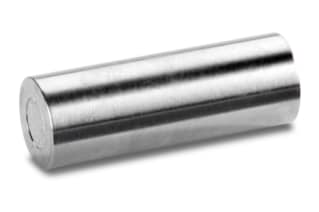
Delta-Pak packings are based on a highly stable, bonded, endcapped 5µm or 15µm spherical silica. Delta-Pak is available in two different pore sizes (100Å and 300Å) with either C4 or C18 bonded phase. Delta-Pak packings are available in different cartridge and column configurations, providing consistent and predictable scale-up capabilities for milligram-to-gram scale purification. Also, by having the same chemistry available on a high-efficiency 5µm particle, you can easily check the purity of your fractions.
|
Chemistry |
C4 |
|
Separation Mode |
Reversed Phase |
|
Particle Substrate |
Silica |
|
pH Range Min |
2 pH |
|
pH Range Max |
8 pH |
|
Maximum Pressure |
6000 psi (415 Bar) |
|
Endcapped |
Yes |
|
Silanol Activity |
Low |
|
Molecular Weight Range Min |
1000 |
|
Molecular Weight Range Max |
30000 |
|
Particle Shape |
Spherical |
|
Particle Size |
5 µm |
|
Pore Size |
300 Å |
|
Format |
Guard Column |
|
Surface Area |
125 |
|
System |
HPLC |
|
USP Classification |
L26 |
|
Inner Diameter |
3.9 mm |
|
Length |
20 mm |
|
Carbon Load |
3 % |
|
UNSPSC |
41115709 |
|
Application |
Protein |
|
Brand |
Delta-Pak |
|
Product Type |
Guards |
|
Units per Package |
2 pk |

Delta-Pak C4 Guard Column, 300Å, 5 µm, 3.9 mm X 20 mm, 1K - 30K, 2/pk
Delta-Pak packings are based on a highly stable, bonded, end-capped 5m or 15m spherical silica that is ideal for the separation of peptides, proteins, and natural products. Delta-Pak is available in two pore sizes (100 and 300) with either a C4 or a C18 bonded phase. Delta-Pak packings are available in a variety of cartridge and column configurations, allowing for consistent and predictable milligram-to-gram scale purification. You can also easily check the purity of your fractions by having the same chemistry available on a high-efficiency 5m particle. The 15 m packing is available in analytical-scale dimensions for preliminary preparative chromatographic analysis, peptide mapping, and fraction-purity testing. Particle size has no effect on the chemical properties of the packing materials.
All of our lab equipment is manufactured under strict conditions and subjected to stringent quality assurance standards, ensuring that you only receive high-quality products from your lab. Our website has columns, guards, vials, and elution plates to meet all of your analytical needs. We provide a variety of brands and versions that have been specifically designed to meet the needs of every type of chromatographic analysis. Visit our website to shop for lab equipment directly to find the right equipment for your lab needs.
Browse our website to find other Waters products and collections, and shop for lab equipment that meets your needs. You may also be interested in checking out Reversed-Phase QC Reference Material; The Reversed-Phase QC Reference Material is a special assortment of standards and mixtures that can be found in the portfolio of Quality Control Reference Materials. These products enable the user to evaluate and benchmark their chromatography system prior to performing critical material analysis. The portfolio's products have all been specially formulated based on the expertise of Waters scientists. The Reversed-Phase QC Reference Material is a highly complex reference material mixture that contains compounds that may be difficult to separate. It is intended to provide this complexity and is appropriate for routinely performing complex assays. It is compatible with a wide range of column chemistries and dimensions, as well as system hardware. This standard mixture should be used to validate the analytical HPLC or UPLC system's benchmark performance. This QC Reference Material is a specially formulated blend of void markers and neutral, acidic, and basic compounds.
What Does Achieving High Resolution Mean in Chromatography?
Since peak width and retention time, which are both essential components of the chromatographic process, are functions of resolution, resolution can be used to enhance separations. As a result, higher resolution means better and more accurate data evaluation.